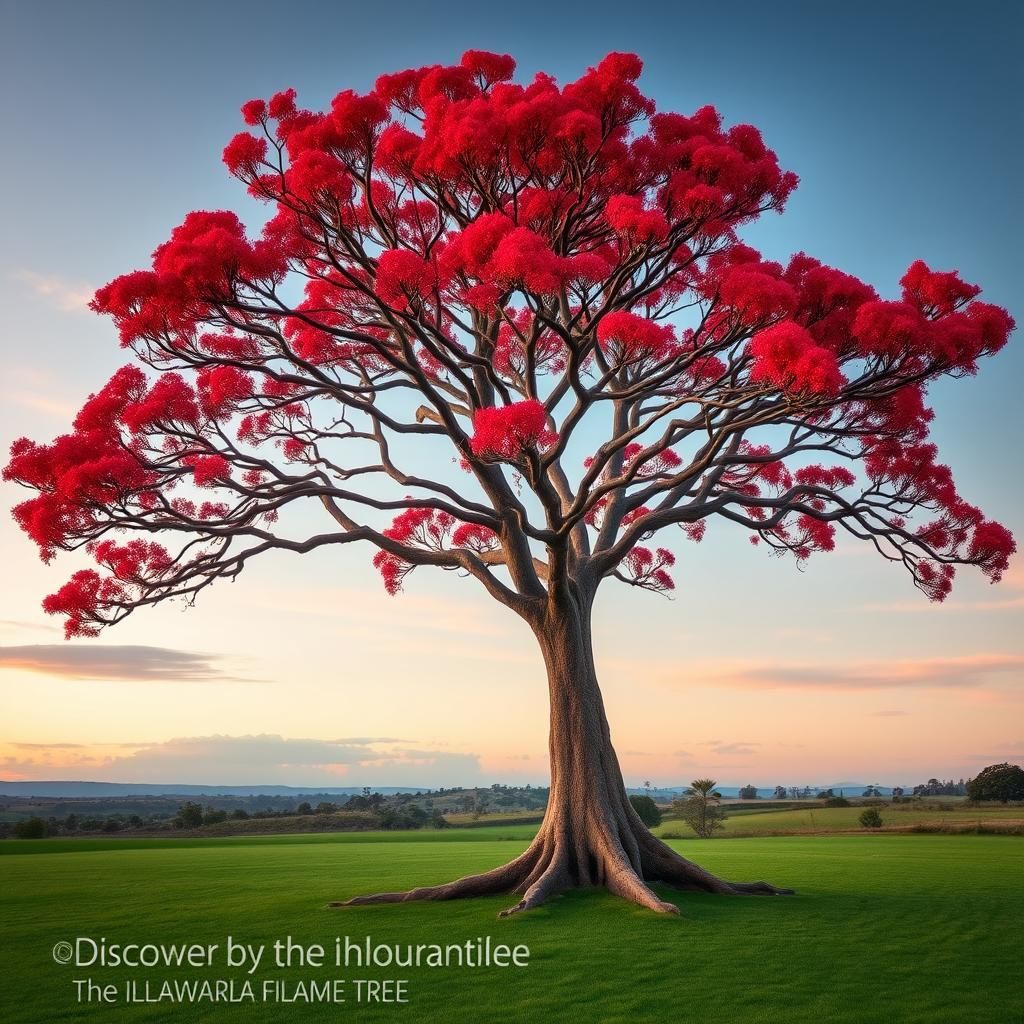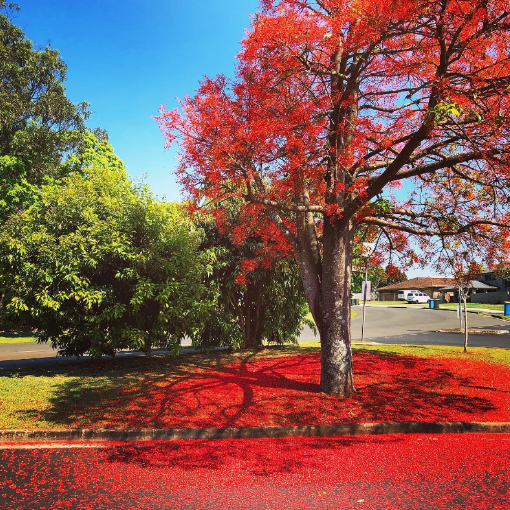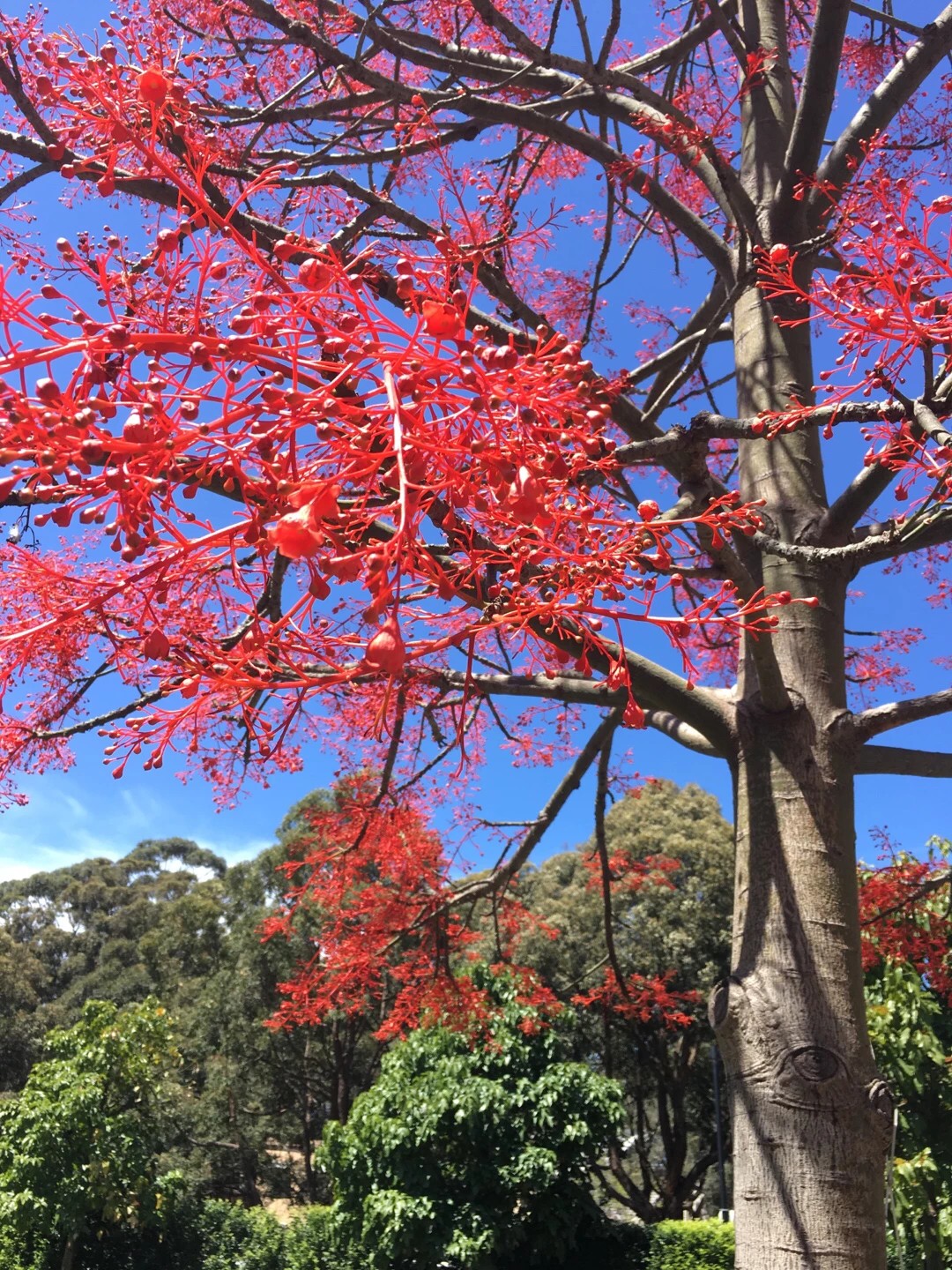Discover the Beauty and Significance of the Illawarra Flame Tree Australia

The Illawarra Flame Tree, native to Australia, stands as a vibrant testament to the country’s rich botanical diversity. Renowned for its striking orange-red blossoms, this tree not only captivates the eye but also plays a vital role in its ecosystem. Its unique adaptations to local conditions make it a symbol of resilience and beauty. In this article, we will explore the stunning aesthetics of the Illawarra Flame Tree, delve into its ecological significance, and highlight its cultural importance to the regions it inhabits. Join us in discovering the enchanting allure of this remarkable tree that graces the Australian landscape.
Illawarra Flame Tree: A Vibrant Symbol of Australia
The Illawarra Flame Tree (Brachychiton acerifolius) is a stunning native Australian species, renowned for its breathtaking clusters of bright orange-red flowers that bloom in late spring and early summer. This deciduous tree can reach heights of up to 30 meters and is characterized by its glossy, maple-like leaves, which provide a striking contrast to its vibrant blooms. Predominantly found in the Illawarra region of New South Wales, this tree not only enhances the landscape but also plays a significant ecological role, providing habitat and food for a variety of native creatures. Additionally, the Illawarra Flame Tree has become a popular choice in urban landscaping due to its aesthetic appeal and resilience to drought conditions.
Botanical Characteristics
The Illawarra Flame Tree is a deciduous tree that can grow up to 30 meters tall with a wide canopy. Its leaves are typically glossy and are shaped similarly to maple leaves, providing a lush presence in gardens and parks. The magnificent clusters of red flowers bloom warm in the spring, creating a visual spectacle that attracts birds and pollinators, signaling the arrival of the warmer months.
Habitat and Distribution
This tree species is predominantly found in eastern Australia, specifically in the Illawarra region of New South Wales, where it thrives in coastal and upland environments. The Illawarra Flame Tree favors well-drained soils and can often be seen growing near cliffs and in open forests. The tree's natural habitat extends along the coast, demonstrating its adaptability in various environmental conditions.
Ecological Importance
The Illawarra Flame Tree plays a crucial role in its ecosystem by providing food and habitat for various native wildlife. The nectar from its flowers attracts a range of birds, including honeyeaters and butterflies, while its foliage offers essential shelter for numerous small animals. By supporting biodiversity, the tree contributes significantly to the ecological balance of its native environment.
Cultural Significance
The Illawarra Flame Tree holds a special place in Australian culture. It is often celebrated in local art and festivals, symbolizing the vibrant beauty of the Australian landscape. Additionally, this tree is sometimes planted in public spaces to commemorate special occasions, as its stunning blooms evoke feelings of joy and community pride, making it a cherished species.
Care and Maintenance
For those interested in cultivating the Illawarra Flame Tree, proper care and maintenance are essential. This tree thrives in full sunlight and requires well-drained soil to prevent root rot. Regular watering is necessary during the establishment phase, but once mature, the tree demonstrates remarkable drought resistance. Pruning is advisable to maintain its shape and encourage healthy growth, allowing it to become a striking addition to any garden or landscape.
| Aspect | Details |
|---|---|
| Height | Up to 30 meters |
| Leaves | Glossy, maple-like |
| Bloom Season | Late spring to early summer |
| Native Region | Illawarra, New South Wales |
| Ecological Role | Habitat for wildlife |
Is the Illawarra Flame Tree native to Australia?

Yes, the Illawarra Flame Tree, scientifically known as Brachychiton acerifolius, is indeed native to Australia. Primarily found in the Illawarra region of New South Wales, this remarkable tree is recognized for its vibrant, red flowers that bloom in late spring and summer, creating a striking visual display. The Illawarra Flame Tree thrives in sub-tropical and temperate environments, indicating its adaptability to specific climatic conditions native to eastern Australia. The tree can reach heights of up to 30 meters and is often used in landscaping due to its ornamental value and shade-providing capabilities.
Geographic Distribution
The Illawarra Flame Tree is native primarily to the coastal areas of eastern Australia. Its range includes:
- New South Wales: Specifically predominant in the Illawarra region around cities like Wollongong.
- Queensland: Some populations can be found in the northeastern parts, although less common.
- Other Regions: Rare sightings can occur in local gardens and parks outside its native range.
Ecological Importance
The Illawarra Flame Tree plays a crucial role in its native ecosystem. It provides:
- Habitat for Wildlife: Birds and insects are attracted to its flowers, aiding in pollination.
- Soil Stabilization: The tree's root system helps prevent soil erosion in its native habitat.
- Biodiversity Contribution: As a native species, it supports local flora and fauna.
Cultural Significance
Within Indigenous Australian cultures, the Illawarra Flame Tree holds various meanings:
- Traditional Uses: Indigenous communities have utilized its bark and wood for crafting tools and shelters.
- Cultural Symbolism: The striking flowers have inspired art and storytelling.
- Community Plantings: The tree is often planted in community spaces, connecting people to their natural heritage.
Garden and Landscape Use
Due to its beautiful flowers and overall appearance, the Illawarra Flame Tree is widely used in landscaping:
See also:
- Ornamental Flowering: The vivid blooms attract attention and add color to gardens.
- Shade Provision: Its large canopy provides significant shade, making it ideal for parks.
- Low Maintenance: Once established, the tree requires minimal care, making it suitable for various settings.
Conservation Status
The conservation status of the Illawarra Flame Tree is of interest to ecologists:
- Not Endangered: Currently, the tree is not classified as endangered; however, it requires appropriate habitat management.
- Threats: Urban development and land clearing pose risks to its natural populations.
- Conservation Efforts: Local councils and organizations work to preserve its habitat and promote planting in urban areas.
Are Illawarra flame trees poisonous to dogs in Australia?

The Illawarra flame tree (Brachychiton acerifolius), known for its striking orange-red flowers, is common in Australia's eastern coastal regions. Regarding its toxicity to dogs, it is important for pet owners to understand the implications of ingestion.
Toxicity of Illawarra Flame Trees
The Illawarra flame tree is not considered highly toxic to dogs. Research indicates that while the tree does possess certain compounds, such as saponins, it does not pose a significant threat to canine health.
- The leaves and flowers may cause mild stomach upset if ingested.
- Severe toxicity symptoms in dogs are rare, but possible reactions include vomiting and diarrhea.
- It is always advisable to monitor your pet if they consume any part of the tree.
Symptoms of Ingestion
If a dog ingests parts of the Illawarra flame tree, the symptoms are generally mild. However, it is crucial to recognize any changes in your pet's behavior or health.
- Signs can include vomiting, diarrhea, and increased drooling.
- Some dogs may also show signs of abdominal discomfort or lethargy.
- In most cases, these symptoms are self-limiting but may require veterinary attention in severe instances.
Preventing Ingestion
To minimize the risk of your dog consuming any part of the Illawarra flame tree, consider implementing preventive measures.
- Keep your dog on a leash when walking in areas where these trees are located.
- Regularly monitor your garden and ensure any fallen leaves or flowers are cleaned up promptly.
- Provide your dog with alternative safe chewing options to deter them from exploring the tree.
Consulting a Veterinarian
If you suspect your dog has ingested parts of an Illawarra flame tree, consulting a veterinarian is important for peace of mind.
- The veterinarian can provide recommendations based on your dog's size and the amount ingested.
- They may suggest symptomatic treatment to alleviate any discomfort your dog is experiencing.
- Keeping your veterinarian informed about your dog's dietary habits can help manage any potential toxicity concerns.
Alternatives to Illawarra Flame Trees
If you're considering planting trees in your garden, it may be worthwhile to explore options that are safe for pets.
- Look for trees that are recognized as non-toxic to dogs, such as maple or dogwood varieties.
- Always research the toxicity levels of plants and trees before introducing them to your yard.
- Consider consulting with a landscaping professional who can recommend dog-friendly options.
What is the Illawarra Flame Tree good for?

The Illawarra Flame Tree (Brachychiton acerifolius) is a native Australian tree known for its striking floral display and various ecological and practical benefits. This species is primarily sought after for ornamental purposes and is recognized for its adaptability to urban environments. Below are some key benefits and uses of the Illawarra Flame Tree.
1. Ornamental Value
The Illawarra Flame Tree is highly valued for its aesthetic appeal. Its bright red flowers bloom during the warmer months, making it a popular choice for landscaping.
- Provides stunning visual appeal in gardens and parks.
- Attracts attention and beautifies public spaces.
- Can be used as a focal point in residential landscaping.
2. Wildlife Habitat
This tree plays a significant role in the ecosystem by offering a habitat for various wildlife species. The blossoms of the Illawarra Flame Tree attract numerous pollinators, including birds and insects.
- Serves as a food source for nectar-feeding birds.
- Provides shelter for native fauna, contributing to biodiversity.
- Encourages pollinator activity essential for plant reproduction.
3. Erosion Control
The Illawarra Flame Tree has a robust root system that is effective in soil stabilization and erosion control. This makes it particularly suitable for planting on slopes and areas prone to soil displacement.
See also:
- Reduces soil erosion in garden beds and landscaped areas.
- Improves soil quality and prevents degradation.
- Helps maintain the integrity of local water systems.
4. Shade Provision
With its large canopy, the Illawarra Flame Tree provides ample shade, making it a valuable asset in hot climates. This can enhance outdoor livability in urban and suburban settings.
- Offers a cool retreat in gardens and parks, encouraging outdoor activities.
- Reduces the need for air conditioning in nearby buildings.
- Contributes to lowering urban heat island effects.
5. Low Maintenance Requirements
One of the appealing features of the Illawarra Flame Tree is its low maintenance needs. Once established, it requires minimal care, making it an attractive option for homeowners and landscapers alike.
- Requires little watering once established, suitable for drought-prone areas.
- Resistant to many pests and diseases.
- Minimal pruning needed, simplifying care routines.
What does the Illawarra Flame Tree symbolize?

The Illawarra Flame Tree, scientifically known as Brachychiton acerifolius, holds significant cultural and ecological symbolism, especially in its native Australian environment. Here are some of the key aspects of what this tree symbolizes:
Cultural Significance
The Illawarra Flame Tree is deeply rooted in Australian Indigenous culture. It symbolizes strength and resilience, reflecting the endurance of Indigenous communities throughout history. This tree is often associated with:
- Traditional Uses: Indigenous Australians have traditionally used various parts of the tree for food and medicine.
- Connection to Land: The tree serves as a reminder of the spiritual connection that Indigenous people have with the land.
- Seasonal Changes: Its vibrant red flowers herald the arrival of summer, marking a seasonal change that is significant to local cultures.
Ecological Role
The Illawarra Flame Tree plays an essential role in the local ecosystem. It provides habitats and food for various species, emphasizing its importance in biodiversity. Key ecological aspects include:
- Habitat: This tree serves as a habitat for many birds and insects, supporting local wildlife.
- Pollination: The bright flowers attract pollinators, making it crucial for the reproduction of many plant species.
- Soil Enrichment: Its leaf litter contributes to nutrient recycling in the ecosystem, enhancing soil quality.
Ornamental Value
The Illawarra Flame Tree is widely appreciated for its stunning aesthetic appeal, symbolizing beauty and uniqueness in landscape design. Some ornamental features include:
- Flowering Display: This tree bursts into vibrant red blooms, creating a striking visual during the flowering season.
- Street Trees: Often planted along streets and parks, its majestic height and colorful foliage enhance urban aesthetics.
- Symbol of Pride: In many communities, the Illawarra Flame Tree represents local pride and identity, being a distinctive part of the landscape.
Environmental Indicators
The health and presence of the Illawarra Flame Tree can indicate the environmental status of its surroundings. As a bioindicator, it symbolizes:
- Ecosystem Health: A thriving population suggests a healthy environment, free from pollution and conducive to biodiversity.
- Climate Adaptation: Its ability to withstand harsh conditions showcases the resilience needed for adapting to climate change.
- Conservation Awareness: The tree's presence often raises awareness about the need for conservation efforts in local habitats.
Symbol of Community and Identity
In various regions, the Illawarra Flame Tree serves as a symbol of community and identity. Its significance in society is highlighted by:
- Civic Pride: Many towns feature this tree in their logos and branding, reinforcing a common identity.
- Festivals and Events: Local festivals often celebrate this tree, linking community spirit with environmental awareness.
- Historical Significance: Its history within the community often connects generations and strengthens community bonds.
Questions from Our Readers
What is the Illawarra Flame Tree?
The Illawarra Flame Tree (Brachychiton acerifolius) is a striking Australian native tree known for its vibrant red flowers that bloom in late spring and early summer. This tree, which can grow up to 25 meters tall, is often found in the coastal regions of New South Wales and is popular for both its ornamental beauty and its capacity to attract local wildlife.
Where can I find Illawarra Flame Trees?
Illawarra Flame Trees are primarily found in the Illawarra region of New South Wales, Australia. They thrive in sub-tropical climates and are commonly seen in parks, gardens, and along streets where their stunning floral display can be appreciated by the public.
How do you care for an Illawarra Flame Tree?
Caring for an Illawarra Flame Tree involves ensuring it has well-drained soil and suitable sunlight, as these trees prefer full sun. Regular watering, especially during dry periods, is important to support their growth, and pruning should be conducted to maintain their shape and health.
Are Illawarra Flame Trees suitable for small gardens?
While Illawarra Flame Trees are beautiful, they may not be ideal for small gardens due to their potential size and spread. However, smaller cultivars or younger specimens can be planted if you have space, but planning for their growth is essential to avoid over-crowding.
See also:

If you want to read more articles like Discover the Beauty and Significance of the Illawarra Flame Tree Australia, we recommend you check out our Landscaping category.
Leave a Reply
Related Articles